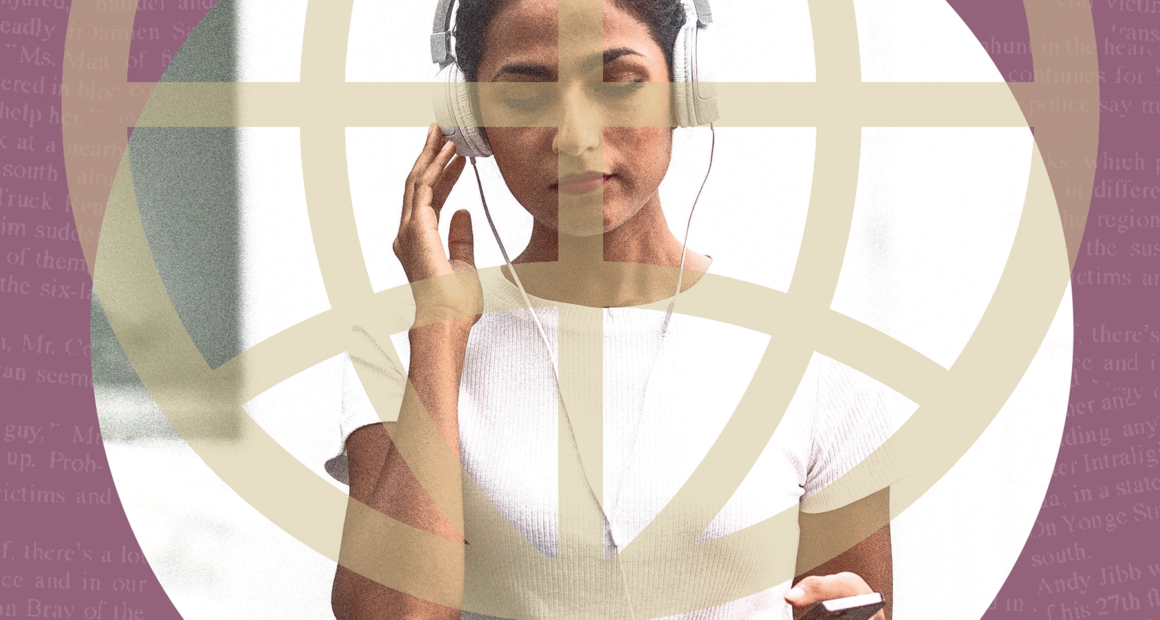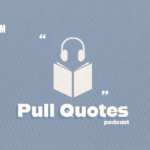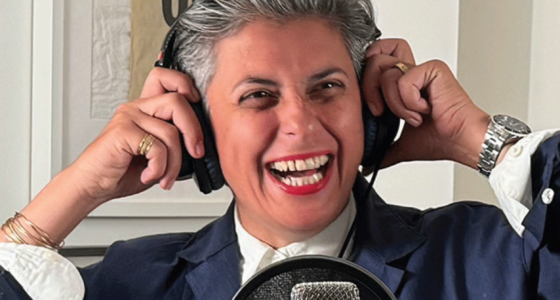Amid the onslaught of daily news, four in-depth podcasts are taking their time—and getting the story right

April 23, 2018, just after 1:30 p.m. A shrill ringtone fills the air, or, as The Big Story podcast host Jordan Heath-Rawlings describes it, “the typical hubbub of a newsroom swinging into action when there’s something major going on.”
The breaking news: A vehicle has just run over multiple pedestrians in North Toronto in what appeared to be a deliberate attack.
When the call arrived, Heath-Rawlings and his team had been busily making a prelaunch practice episode for The Big Story, Rogers Sports & Media’s daily news podcast. Although Heath-Rawlings can’t recall the specifics, the team had spent that morning selecting a topic for the day’s dry run and then finding the appropriate guest to interview.
The show’s format had been established early: a daily “deep dive,” taking one story and examining it in depth through an interview with an expert or reporter who had covered the issue—or the “a smart person talks to a curious person” format, as Heath-Rawlings puts it. (“I’m the curious person, not the smart one,” he cautions.)
But as the details of the attack came in, the team pivoted. Quickly, they discounted interviewing an at-the-scene journalist. “They don’t know much other than what’s right in front of them,” Heath-Rawlings recalls thinking. “We don’t know the motive. We don’t know who it was. We don’t know anything.” Barring piecemeal updates, this was unlikely to change for the rest of the day. They needed someone who could provide a deeper insight.
The day’s major sub-story thus far had been the officer who calmly managed to take the attacker into custody. One of The Big Story’s producers knew of someone who ran a business teaching rapid-response de-escalation techniques to police. She tracked him down at his cottage, which meant the interview would have to be done over the studio phone. “So not the best quality,” says Heath-Rawlings. Once they got him on the line, Heath-Rawlings asked him, among other things, what he would tell an officer to do in this situation, and how often an incident like this could turn into something more deadly.
The interview was finished at 4 or 5 p.m. “It was acceptable for what it was,” says Heath-Rawlings. “It didn’t provide any insight into what the hell had just happened. It was literally, ‘Hey, you saw this image of a cop de-escalating [the situation]. Here’s how they do that.’” The episode itself was put to bed at around 8 p.m.
Listening to it the next day was just as unedifying. Overnight, the media found the killer’s Facebook account, revealing his motive. The incel movement was all journalists wanted to talk about.
But it was a lesson learned. Now The Big Story crew had a better understanding of what not to do when putting together a deep-dive daily news podcast: there was more to it than simply chasing the latest breaking news. It was the kind of insight producers of such shows would likely have been developing since Slate’s 2014 launch of The Gist—the genre’s progenitor.
The Reuters Institute for the Study of Journalism (RISJ) has been analyzing daily news podcasts since 2019. In a November 2020 report, covering the United States, the United Kingdom, Australia, France, Sweden, and Denmark, the organization hailed the deep dive as a news-media success story. It noted that these podcasts provide listeners with deep background and analysis through a compelling listening experience that uses narrative storytelling techniques and warm, likeable hosts. Based on conversations with publishers, the report judged them, as well as other daily news podcast forms, to be “one of the fastest growing areas of media consumption,” achieving steady growth in audiences and advertising revenue, with some even turning a profit. They also helped outlets pursuing subscription-based business models retain subscribers.
Daily news podcasts are “one of the fastest growing areas of media consumption” says the Reuters Institute for the Study of Journalism
Canadian legacy media outlets have taken careful note of the genre’s success. Since June 2018, four have launched their own deep dives: The Big Story, the inaugural podcast of Rogers’s Frequency Podcast Network (of which Heath-Rawlings is executive producer); The Globe and Mail’s The Decibel; the Toronto Star’s This Matters; and CBC’s Front Burner. For over four years, they have been providing more and more Canadian news consumers with an alternative to the capricious hysteria of the 24-hour news cycle, taking them beyond the headlines with a painstakingly researched yet current, profound but accessible, measured while also unflinching dose of contextualization and analysis—daily.
Although the deep dive first emerged in 2014, it was not until The New York Times launched The Daily in February 2017 that it really took off. Noting the popularity of narrative podcast series such as Serial, the Times decided news podcasting would be the ideal medium to showcase the depth and range of its reporting to nonsubscribers for free. Short-term revenue was less important. “It’s more about opening the top of our funnel and bringing Times journalism to a new audience who we think will eventually become our next generation of subscribers,” Erik Borenstein, then the Times’s director of audio told the RISJ. First, in 2016, it launched The Run-Up, a biweekly show about the presidential election hosted by Michael Barbaro, a Times politics reporter who had previously worked in print news. It achieved such traction that the Times decided there would be an audience for a general-interest, daily news podcast. After some initial experimentation, the Times decided The Daily, also hosted by Barbaro, would analyze one major news story through an immersive, narrative-driven, 20- to 25-minute interview with a Times reporter covering that story.
The show was a surprise hit due, in large part, to Barbaro’s conversational and intimate tone. Listeners enjoyed his slow, deliberate delivery; the sudden grunts of recognition he used to mark his guests’ more salient points; his chumminess with his Times colleagues; and his willingness to show emotion when the moment demanded it. “It’s a 20-minute update murmured in your ear by a well-informed, sensitive, funny, modest friend—the kind of person who has as many questions as answers,” Rebecca Mead wrote in The New Yorker in 2017. In June 2018, The Daily had achieved 1.1 million average downloads per day. By April 2019, this had doubled to two million. By fall 2020, it had reached four million.
Following The Daily’s success was a surge of deep-dive launches, including from Vox Media, The Guardian, The Economist, The Washington Post, and The Wall Street Journal.
Traditional broadcast radio does have daily, in-depth interview shows such as CBC’s The Current. But when you compare these with deep dives, “storytelling is a big difference,” says Aura Lindeberg, who researched news podcasting as an RISJ fellow in 2018 and 2019. “In radio, you use the time you have to go straight to the point.” But deep-dive hosts can take their time, asking guests to set the scene, bringing listeners along a carefully crafted narrative arc. “It can be storyboarded, postproduced in such a way that is more than just one person talking to another person,” notes James Cridland, editor of Podnews, an international podcasting newsletter. Questions and answers can be comingled with atmospheric music, scripted narration, field recordings, and illustrative audio-news clips, immersing the listener in the story.
Deep dives are also a more intimate listening experience. “Part of the reason why is that most of us listen to podcasts with earphones,” says Bernard Graham, a professor of audio journalism at Western University in Ontario. “We’re almost sitting at the same table with these people and hearing their conversation.” In addition, the hosts generally diverge from the formal, staid delivery of traditional radio in favour of something natural and friendly, and thus more appealing to the youngish target audience. According to the RISJ’s 2020 digital news report, 43 percent of people aged 18 to 24 and 40 percent of those aged 25 to 34 listened to podcasts, as opposed to the 11 and 19 percent from those respective age cohorts who listened to radio news. News podcast listeners skewed slightly older, but still significantly younger than radio news listeners. “Therefore,” says Cridland, “you will have something that is a little bit more informal, young-person friendly.”
Therein lies a major reason why news outlets have introduced daily news podcasts: “to attract younger audiences and to engage them more deeply with their brands,” according to the RISJ’s November 2020 report. News organizations pursuing subscription-based business models also hope to generate new subscriptions and retain existing ones. “In conversations I’ve had with publishers, the numbers are pretty small in terms of getting subscribers through that route,” says Nic Newman, senior research associate at the RISJ and coauthor of the report. What they are doing right now, however, is helping to keep people subscribed. Some publishers have tried to measure the consumer habits of their long-term, retained subscribers to determine why they continue to subscribe. Newman continues, “They do find in their data that people who regularly use their podcasts are much more likely to stay subscribed.”
Outlets also want to see their daily-news podcasts generate revenue. Podcast advertisements, the primary source of revenue for most of these shows, are significantly more valuable than other forms of digital advertising. “The attention that people pay to podcast ads, there’s really nothing else quite like it,” says Jeff Vidler, president and founder of Signal Hill Insights, a Canadian audio research provider. “Sure, you can skip them,” he says, but “there aren’t that many ads. And if they’re host-read, listeners will hang in there with them.” This enables most publishers in large media markets, such as the U.S. and U.K., to cover the costs of their podcasts. Some even make a profit. In small media markets, such as Denmark, the requisite advertising revenue simply isn’t available. As a result, publishers there have introduced subscription- and donation-based models. According to Newman, in a medium-sized market like Canada, “If you can demonstrate that you have a large-enough audience, you should be able to cover your costs, at least, through advertising.”
Front Burner had a massive head start in building an audience, according to Jeff Ulster, copublisher of the Canadian Podcast Listener, a survey that researches the Canadian podcast market. When it launched, large numbers of consumers had already been aware of and invested in CBC’s digital audio content for years. As a result, its listenership is larger than many of its competitors’. In August 2022, CBC reported that the show had reached two million monthly downloads. By Ulster’s estimation, the other three podcasts have still achieved steady growth, but from a standing start.
Unlike in radio news, deep-dive hosts can take their time, asking guests to set the scene, bringing listeners along a carefully crafted arc
Audio experts give Canada’s deep dives high marks for their exceptional interviewing, but think they have yet to match the storytelling quality of major U.S. and British shows. The latter cut loose from the straight interview format and incorporate narrative storytelling techniques more often, such as using original music composed specifically for the episode to create a certain mood, interspersing the dialogue with scripted narration, and including reporters’ extended field recordings to introduce different points of view—something resembling a “talk-tape.” For the most part—but not always—“daily deep dives in Canada very much follow a format,” says Graham. “They don’t go into the storytelling toolbox as much as we see with some of the other publishers in the world.”
The reason for this is simple: Canadian deep dives have far fewer people working on them. “Literally, you just have to listen to the credits at the end of any of these major podcasts,” says Angela Misri, an assistant professor at Toronto Metropolitan University’s School of Journalism. Front Burner, Canada’s best-resourced deep-dive daily podcast, has seven full-time staff (a host, an executive producer, four producers, and a mixer), two part-timers, and sometimes an intern. According to their respective websites, 14 people work on Vox’s Today, Explained and 15 on The Washington Post’s Post Reports. The Daily has over 40 members of staff. Underresourcing deep dives “will often result in just interviews,” says Misri, “because they’re simpler and easier to structure and punch out in editing.” Ulster says that the market size places limits on how much investment Canadian podcasts can get and how much revenue they can make. Therefore, availability of resources is mostly tied to the size of the media market. But also, adds Misri, major U.S. and British shows have more buy-in from the publishers. By contrast, Canadian deep dives have yet to receive their fair share of an admittedly smaller pool of resources. “It’s not that the talent doesn’t exist here,” Misri says. “It’s just that we don’t put our money where our mouth is.”
The deep-dive daily news podcast has nevertheless made an overwhelmingly positive contribution to Canadian journalism. “I spend a lot of time mourning journalism and newsrooms,” says Pauline Dakin, a professor of audio journalism at University of King’s College in Halifax. But, she adds, deep dives have “demonstrated that there is still interest in good journalism—in deep, contextual reporting.” This gives her hope that journalism’s current decline in fortunes is not existential and terminal. “It’s just more evidence that it’s all about the grand interruption of the internet.”
Producing a quality deep dive is a major commitment of resources. Besides the actual recording, topics need to be researched well in advance, interviews planned out, narratives carefully crafted, and soundscapes engineered. At The Decibel, the producer assigned to a given episode generally has a day or two to investigate it, according to Kasia Mychajlowycz, the show’s senior producer until February 2023. (She was still in the role when she spoke with the author.) The Globe’s own journalism is the first stop. The producer reads the paper’s coverage and talks to the reporters behind it. Sometimes, they also look at related studies and reports, and then start working the phones to glean even more relevant information. The result of all this effort is the episode’s research document. Simultaneously, the producer will look for suitable audio clips to insert in the edit, to make the episode more vivid. They stick to clips recorded by Globe reporters, from newswire services—like Reuters—and ones that fall under fair dealing.
Sometimes, choosing the guest is a no-brainer—like when a Globe reporter has extensively covered the story. When a producer is looking for an external expert, there are often multiple candidates. Regardless, the producer tends to hold a preinterview with the individual—or everyone on the shortlist. The final choice is made based on both the guest’s expertise and ability to communicate in an accessible and absorbing way—the producer is looking for someone whose answers can be crafted into a narrative. “We have to convey the information in a vehicle that people want to be in,” says Mychajlowycz. “We need them to get on the ride, to be able to absorb the information.”
The producer then takes the research document and preinterviews to compose a rough line of questioning, or Q-line in industry parlance. For this, there is a hierarchy of priorities, according to the host of The Decibel, Menaka Raman-Wilms. “Once we’ve got all the information there, we want to make sure it’s delivered in a way that’s easy to understand, and that’s compelling and interesting.” The structure depends on the topic under consideration. But generally, they try to think of the biggest, most obvious questions—the ones that will be top of mind for all listeners when they read the episode description—and list those first. Then, the questions’ depth and specificity typically increase as they progress. Raman-Wilms and either the show’s editor or senior editor look each Q-line over with the producer. The aim is to provide a fresh perspective, to make sure that the questions are ordered correctly, and that they aren’t overlooking anything. According to Mychajlowycz, beneath each question the producer will add a bullet-point list of all the facts they are expecting the guest to use in their answer, taken from all their research—including from the given guest’s preinterview. Guests’ responses will be checked against these during recording, in case they misspeak. The same goes for Raman-Wilms’s questions. “I think she said ‘Emergency Act’ instead of ‘Emergencies Act’ this week,” recalls Mychajlowycz, referring to a November 2022 episode about the Emergencies Act inquiry. “And we’re like, ‘Well…balls! I guess we’ll go fix it.’”
Boom-boom, duh-duh-dum. Boom-boom, duh-duh-dum.
“From the Toronto Star…I’m Raju Mudhar…and This Matters.” It’s March 25, 2020, and the third episode of the Star’s new deep dive has begun.
“Hi, Toronto Star listeners!” a joyful, squeaky voice shrieks, the infectious chuckle of cohost and producer Mudhar clearly audible in the background. “What’s your name?!” the voice demands. “I would like to know what your name is, because I don’t know anyone’s name.”
“What’s it like being on March Break with everything closed, and with mummy and daddy both working from home?” asks Mudhar, managing to compose himself.
“Bo-ring!” the voice moans. “I want to go rock climbing, sir!”
“You also miss school, right?”
“Ye-es,” the voice replies, matter-of-factly.
“Why are you missing school?”
“Because I would like to see my friends, which I can’t, which is boring.”
The day’s episode, based around an interview with a Toronto-based geriatrician, was about the so-called sandwich generation—Generation Xers and millennials bringing up young children while looking out for, even caring for, aging parents. The pandemic was making their already tricky situations more difficult. On the one hand, they were juggling working from home with entertaining bored, housebound children; on the other, they were fretting over their parents, many of whom, despite the risk COVID-19 posed, weren’t taking it sufficiently seriously.
Whenever a guest is new to the show, Mudhar tries to reassure them. “We have amazing sound people,” he says. “They make me sound good, so they’ll make you sound good.” Although he goes in with prepared questions, he treats them more like a guide. If the guest takes the conversation in an unexpected, interesting direction, he needs to be willing to follow them. Even though the show may be a “choreographed conversation,” as Mudhar terms it, it’s still a conversation. But he also has to bear his listeners in mind. Too often, guests forget they aren’t just speaking to a journalist who has researched the topic in-depth. If they mention concepts that some might not be familiar with, Mudhar has to be alert and ask them to explain them. “I want to sound like I’m an idiot,” he says. “Like I’m bringing an audience to this as if they know nothing. I want the conversation to be as open as possible for as many people as possible.”
Mudhar keeps things informal and casual. He’s not there to grill his guests like a buttoned-up radio or television interviewer. He treats them almost like social guests. “I’m Indian,” Mudhar says. “One of the things you are taught is that the guest is important. You have to always be the ultimate host.” If people he interviews were in his home, he would give them food. “I can’t, but I want to make this as warm as possible for them.” Often, guests are fellow Star reporters. As someone “like the furniture around the Star,” Mudhar knows and gets along with most of them, which makes creating this atmosphere easier. Prerecording, he starts the interview with a quick, “How’s the family?” Postrecording, they gossip together.
In terms of his delivery, Mudhar doesn’t try to moderate his enthusiastic tone. “This is me,” he says. “I get excited about things. I laugh a lot during the interview—during my questions—and it gets cut out.” Sometimes, if it works, his peals of laughter will be left in. He wants to show his listeners the real Raju Mudhar, more or less. Sometimes the story demands it. So, with young children and older parents of his own, Mudhar decided to put himself out there and offer listeners a highly effective window into the reality of the sandwich generation.
Once an interview has been recorded, Mudhar and the on-duty producer pore over the transcript and listen back to the audio, making notes for the sound engineer. “It’s ‘that question needs to be reasked,’ ‘that needs to be chopped,’ ‘let’s cut this out.’” They also look for places to insert relevant audio clips. More often than not, This Matters doesn’t record, edit, and publish an episode on the same day. In such cases, the interview will be added to a queue waiting for editing. “It’s amazing,” says Mudhar. “It’s 20 to 45 minutes of audio but it takes three, four hours to get rid of all the ‘ums’ and try and get some clips in there.”
While they await the completed episode from the sound engineer on publication day, the production team does all the back-end procedures needed to upload the episode to the Star’s website and the various podcast distribution platforms. When it arrives, at least three or four people give it a listen for quality-control purposes. Immediately after publishing, they manually check each platform to make sure it works. “And then,” Mudhar says, “we get onto the next one.”
Like everyone else at CBC on the morning of January 6, 2021, Jayme Poisson, host of Front Burner, had the news on. Yes, the images from outside the U.S. Capitol were alarming, but they weren’t at all surprising. It just looked like there was going to be a big protest, she thought. Few could have guessed what it turned into.
Around 1 p.m., Poisson went into the day’s scheduled interview. As usual, she had her laptop open so she could refer to her notes. Soon, email notifications started to dance across her screen, including a back-and-forth between the production team and CBC executives overseeing the show, and a deluge of emails from the corporation-wide, internal-news-alert push system. “They all had a similar subject line: ‘Capitol, Capitol, Capitol,’” Poisson remembers. Although she knew things were happening in Washington, Poisson did her best to complete the interview. “Literally the moment I finished,” she says, “I get this note from my boss: ‘We’re pivoting.’”
The team contacted the Washington bureau to arrange an interview for some point later; exactly when that would be, they didn’t know. Tasks were split up between several producers: one pulled audio clips; another wrote the Q-line with Poisson; a third just drank in the coverage, doing their best to catalogue what was happening. They were awaiting the right moment for a stock-taking interview—namely for someone at the Washington bureau to be free to talk, and, of course, for the day’s events to begin winding down. This turned out to be at around 11:30 p.m. They spoke with two CBC Washington correspondents jointly—Katie Simpson and Paul Hunter—who unpacked the day’s bewildering events as best they could. Hunter says he was running on adrenaline from nonstop TV and radio reporting.
The interview in the can, producer Shannon Higgins and the team got cracking to edit, mix, and quality-check the episode. They wrapped, exhausted, in the early hours of the morning—just in time for their 5-6 a.m. publication slot. “It was such a moment. We understood there was history unfolding,” Higgins recalls. “Front Burner really wanted to help people understand, as much as we could, what had happened and what it might mean for the country.”
Canada’s news podcasts get high marks for exceptional interviewing, but don’t yet match the storytelling quality of U.S. and British shows
Sometimes the daily deep dive needs to provide an immediate situation report. Sometimes an event is so monumental that not to cover it straight away would be to do listeners a disservice.
The Big Story team posts story ideas on a Slack channel. Twice a week, according to Heath-Rawlings, the team holds a video conference. He and the producers go through its contents together, workshopping and refining the ideas, arranging the logistics, and schedule them once they get the seal of approval. Topics fall under various categories: long-standing issues with a clear news hook; perennial issues they think are essential for Canadians to understand; little-known stories that aren’t necessarily vital, but that are nonetheless compelling. “Everything from the town taken over by peacocks,” says Heath-Rawlings, “to Ontario’s little anti-vax capital of the world.”
All the while, they keep an eye on their recent back catalogue. They don’t want to produce too many stories on the same topic, nor restrict their domestic coverage to one part of Canada. One team member is based in Montreal. “One of his jobs is to make sure we’re not too Toronto-centric, and to call us out,” says Heath-Rawlings. “Like, ‘Guys! You know there’s been three Ontario stories this week?’”
Of course, they do still wake up each morning and scan the headlines for major breaking-news stories. They approach this cautiously, however, chastened by the Toronto van attack episode. Not only must the story warrant contextualization and analysis, but they may wait for it to reach its climax, for as much information as possible to come to light, so they can tell a fuller story to listeners.
A 5:40 a.m. CST 9-1-1 call. The caller, from James Smith Cree Nation, reported a stabbing. In the following minutes, more flooded in from the nation. An hour or so later, residents’ cell phones buzzed: Saskatchewan RCMP had issued a dangerous persons alert for the area. Soon, they publicly identified the suspects. The alert had to be extended to the rest of the province—the alleged perpetrators were believed to be fleeing in a vehicle—and then to Alberta and Manitoba. Their vehicle was reportedly sighted in Regina.
At the day’s end, 10 had been killed, almost twice as many injured. Men and women, young and old. Some apparently targeted, others attacked at random. The suspects were evading a Prairie-wide manhunt, their unknown motive leaving the press scrambling, social media chattering. The police, tight-lipped, were combing over the crime scenes, appealing for information.
By the time of the Saskatchewan mass stabbing on the morning of Sunday, September 4, 2022, The Big Story had been airing for over four years. Instead of responding straight away, the team bided its time. The week’s schedule went unchanged, aside from a slight addendum to the Wednesday episode’s intro: “Hey. It’s Jordan. Before we take you to Quebec today for an in-depth look at the provincial election, I thought I’d tell you why we’re not doing an episode focusing on the horrific stabbings in Saskatchewan.
“When we began this project four years ago, our goal was to take you outside of the news cycle, to provide context and answers and thoughtful analysis, and to only bring you the news when there was a way to understand it. And we’ll do that, in the case of this story, as soon as we can. But right now, pieces are still moving, people are sheltering in place, and any episode we recorded would be out of date, and possibly totally irrelevant, by the time you heard it. It turns out…podcasts—not great at breaking news….Meanwhile, until we tell that story, we’ll focus on what we do best.”
In total, The Big Story waited over a week to release its episode on the incident—a lesson, says Heath-Rawlings, they had “learned the hard way over the years.”
About the author
Tim Cooke is a second-year Master of Journalism student at Toronto Metropolitan University. He did his bachelor’s in History and Classics at the University of Toronto. He loves journalism that explores the historical background of current affairs. Last summer, he interned at documentary film production company Primitive Entertainment, working as a production intern on TVO Original Viral News and helping to research a forthcoming project. He hopes to work in documentary film and audio.







